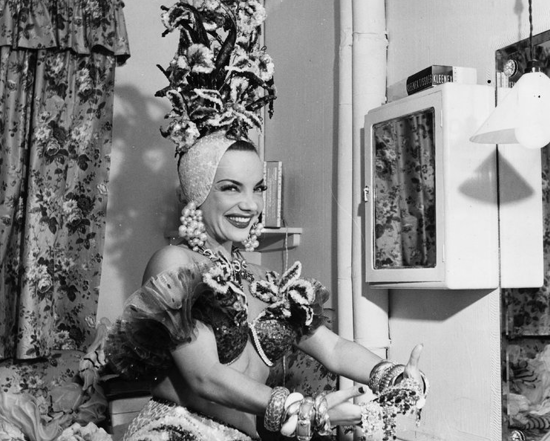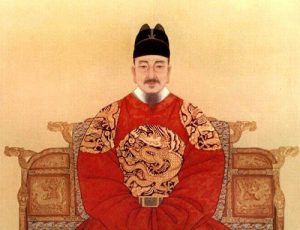Does the name Carmen Miranda sound familiar? What about “the lady in the tutti-frutti hat?” If not, do not feel ashamed, for many have forgotten the excellent Brazilian performer. No Brazilian artist, however, has achieved the international recognition that Carmen Miranda has, especially in Latin America and the States. She was one of the highest-paid women in Hollywood during the 1940’s.1 Yet she is today something of an unknown figure. Why is that?

Well, it dates back to the day she was born. Carmen Miranda was born Maria do Carmo Miranda da Cunha in a village in Portugal on February 9, 1909. She migrated to Brazil with her family in 1910, before turning two years old.2 Though she remained a Portuguese citizen, she was at home in Rio de Janeiro, Brazil. She began performing at a very early age, winning over her family and friends with her talent, and soon she had become a samba sensation. She was cutting records and was a star nearly a whole decade before coming to the United States. One night in 1939, while performing at the famous Cassino da Urca (in a neighborhood in Rio de Janeiro), New York producer Lee Shubert signed her for his show The Streets of Paris on Broadway, and away she went to take the world by surprise.3 While on Broadway, she enchanted everyone with her vibrant singing, dancing, and “Brazilian bombshell” beauty.
At 38 years old she married; however, given the huge persona she was, it is strange that there is not much known about her personal life. The extent of it is that she was raised Catholic, and this may be the reason she married at a mature age. It was rumored that she and her husband, David Sebastian, had a troubled marriage.
It was 1940 when she returned from Broadway to her homeland Brazil, but she was devastated by the way she was received. At the same Casino where Shubert had snatched her from less than a year earlier, Miranda performed to a crowd in awkward silence; only when she began to sing in English did the crowd make some noise, booing. She stopped the show and was so upset that she burst into tears. This incident sent her fleeing from the country, and for about fifteen years she did not return.4
Meanwhile, Miranda spent her time on Broadway and in Hollywood, Las Vegas, and London starring in movies, performing in casinos and clubs, expanding her fame and reputation. She was the tropical beauty from Brazil and there was no one to change her mind about it. Yes, she was a European woman with pale skin and green eyes, but these features are what made her unique, and people found it interesting that a woman like her sang black music. Her unique style gave her the recognition she has acquired as an iconic Latin American. Carmen Miranda was well-known for her outrageously colorful costumes, which called for high platform heels, lots of jewelry, flamboyant dresses, and most famously the turbans with fake fruit stacked so high that it added height to her short stature of 5’0’’. 5 “In Brazil in Bahia, the girls carry the basket with the fruits on her head, and they have big bracelets and big necklaces and they sell fruits in the streets and I take it [my style] from the girls,” Miranda explained as the source of her image.6

For years people have attacked Carmen Miranda on racial grounds. Critics say she had returned to Brazil americanizada. In response, she wrote a song in their mother tongue—the only country in Latin America to speak Portuguese—whose title translates to “They Say I Came Back Americanized.”7 It was also said that she was a sellout and was not truly a native, having been born in Portugal. Some say she was simply portraying the “Brazilian Bombshell” image and embodied the typical stereotype the U.S. public wanted to see in Brazilians, and Latin Americans more generally, where women are highly sexualized. Others argued that her style had created a distorted view of the country, as being sexually exposed, extravagantly colorful, and fruity. They argued that the turbans she wore were not even Brazilian customs and were only used to make fun of her.8 She was even mocked on a Bugs Bunny cartoon. To make matters worse, some said she had no right to sing samba, a music inherited in Brazilian black slums.

On the contrary, Carmen Miranda put Rio de Janeiro on the map of spectacular. She was the most successful person Brazil had produced. In a way, she served as an unofficial ambassador for her country, and it is heavily reflected in her movie roles.9 Everything that was Latin American was a hybrid presented in her performances, her style, her songs, friends and fans. She was everything, and nothing at once: Brazilian, Mexican, Argentinian, Cuban. Hollywood productions during this time period would touch on different cultures, but never fully embrace one, and this may have been what happened to Miranda. She became involved in Franklin D. Roosevelt’s Good Neighbor Policy, which was a program determined to improve relations with the nations of Central and South America.10 She still is the only South American to be immortalized in concrete at Sid Grauman’s Chinese Theatre, “To Sid, VIVA! in the South American Way. Carmen Miranda. March 24th 1941,” neighboring none other than Frank Sinatra. 11 Rio’s Museum of Modern Art welcomed Carmen Miranda with a major retrospective; “Carmen Miranda Forever,” where clips from her movies were shown, and gowns and turbans were showcased. She even had a museum in Rio dedicated to her, the Carmen Miranda Museum. Here, there was a wide variety of arrangements, gowns, costumes, shoes, and anything you can think of that she had performed in. The building itself was not lavish and fabulous as she was. Therefore it did not suit the gems hidden inside. Due to lack of maintenance and funds, it was closed down. It was agreed that Miranda deserved better.12 On the bright side, the museum is being relocated to Rio de Janeiro Museum of Image and Sound, expecting to open anytime soon. 13

It is a difficult task to relate to Carmen Miranda’s plight. She took many chances in leaving Brazil: that of being lost in translation, the crossing of geographical and cultural borders, sounding like herself in a different language, being in a sustained condition of exile. One person could not possibly represent an entire continent, especially one as diverse as that of Latin America with its many rich cultures. Today, it is not rare to be a Brazilian in the United States, in contrast to the way it once was. With that in mind, there is no Brazilian artist that has coped with these issues on the scale that Miranda had to in her prime. A director for a play on Carmen Miranda’s life said it better than anyone: “Carmen hasn’t been forgotten, but she’s been kind of ignored or neglected in recent years.”14 There are people today who have become interested in her, that have opened their minds to who she really was and why she has become an obsolete figure. They will learn that she was a charming, charismatic, comical, and extravagant person, a figure to inspire.15
- Larry Rohter, “Arts Abroad: The Real Carmen Miranda Under the Crown of Fruit,” New York Times, Dec. 13, 2001. Accessed April 13, 2017, http://www.nytimes.com/2001/12/13/theater/arts-abroad-the-real-carmen-miranda-under-the-crown-of-fruit.html. ↵
- Encyclopedia of Latin American History and Culture, 2008, s.v. “Miranda, Carmen (1909-1955),” by John Cohassey. ↵
- Larry Rohter, “Arts Abroad; The Real Carmen Miranda Under the Crown of Fruit,” New York Times, Dec. 13, 2001. Accessed April 13, 2017, http://www.nytimes.com/2001/12/13/theater/arts-abroad-the-real-carmen-miranda-under-the-crown-of-fruit.html. ↵
- Larry Rohter, “Arts Abroad; The Real Carmen Miranda Under the Crown of Fruit,” New York Times, Dec. 13, 2001. Accessed April 13, 2017, http://www.nytimes.com/2001/12/13/theater/arts-abroad-the-real-carmen-miranda-under-the-crown-of-fruit.html. ↵
- Maria Rubia Macedo, “Images of Latin America In the Body and Costumes of Carmen Miranda’s Stylized Baiana: Social Memory and Identity,” Comunicação e Sociedade 24, (2013): 186-209. ↵
- Lulu Garcia-Navarro, “Of Fruit Hats and ‘Happy Tropics,’ A Renaissance for Carmen Miranda,” NPR Parallels, April 22, 2015. Accessed April 13, 2017, http://www.npr.org/sections/parallels/2015/04/22/401467980/of-fruit-hats-and-happy-tropics-a-renaissance-for-carmen-miranda. ↵
- Lulu Garcia-Navarro, “Of Fruit Hats and ‘Happy Tropics,’ A Renaissance for Carmen Miranda,” NPR Parallels, April 22, 2015. Accessed April 13, 2017, http://www.npr.org/sections/parallels/2015/04/22/401467980/of-fruit-hats-and-happy-tropics-a-renaissance-for-carmen-miranda. ↵
- Larry Rohter, “Arts Abroad; The Real Carmen Miranda Under the Crown of Fruit,” New York Times, Dec. 13, 2001. Accessed April 13, 2017, http://www.nytimes.com/2001/12/13/theater/arts-abroad-the-real-carmen-miranda-under-the-crown-of-fruit.html. ↵
- Lulu Garcia-Navarro, “Of Fruit Hats and ‘Happy Tropics,’ A Renaissance for Carmen Miranda,” NPR Parallels, April 22, 2015. Accessed April 13, 2017, http://www.npr.org/sections/parallels/2015/04/22/401467980/of-fruit-hats-and-happy-tropics-a-renaissance-for-carmen-miranda. ↵
- “Good Neighbor Policy,” Office of the Historian, April 13, 2017, https://history.state.gov/milestones/1921-1936/good-neighbor. ↵
- Ralph Morris, “Carmen Miranda, Grauman’s Chinese Theater,” Los Angeles Public Library Photo Collection, Accessed April 13, 2017, https://calisphere.org/item/d381f8bd9fd414dd5661ab0aeeffa4a7/. ↵
- Mac Margnolis, “We Still Have Bananas,” Newsweek (Atlantic Edition) 147, no. 4 (January 23, 2006): 55. ↵
- Lulu Garcia-Navarro, “Of Fruit Hats and ‘Happy Tropics,’ A Renaissance for Carmen Miranda,” NPR Parallels. April 22, 2015. April 13, 2017. http://www.npr.org/sections/parallels/2015/04/22/401467980/of-fruit-hats-and-happy-tropics-a-renaissance-for-carmen-miranda. ↵
- Larry Rohter, “Arts Abroad; The Real Carmen Miranda Under the Crown of Fruit,” New York Times, Dec. 13, 2001. Accessed April 13, 2017, http://www.nytimes.com/2001/12/13/theater/arts-abroad-the-real-carmen-miranda-under-the-crown-of-fruit.html. ↵
- Film clip “Carmen Miranda: ‘Rebola a Bola’ (1941),” from Week-End in Havana, film directed by Walter Lang, 20th Century Fox, 1941. Music by Aloysio de Oliveira and Nestor Amaral, lyrics by Francisco Eugenio Brant Horta, sung in Portuguese by Carmen Miranda. ↵



83 comments
Sydney Nieto
Very interesting article. The fact that she was the highest-paid women in the 1940’s is crazy and how she was on Broadway. It’s sad how after she came back from Broadway she was greeted with “boos”, as she had achieved too much. The fruit basket turban was something I had seen in a lot of shows, so it was cool to see how she was known for that.
Jaedon E
Amazing article!! Personally this articles explanatory narrative catches the reader’s attention with Carmen Miranda’s positives and negatives throughout her career and personal life. Although it’s interesting to find where the fruit baskets are widely used now. Great job explaining why Carmen Miranda has been ignored over the years.
Peter Alva
I like how this article talks about her, normally people don’t talk about icons like her but in her space, she was iconic to women and her impact was huge for culture. Her cultural impact was seen in Brazil which would then be later looked at for having women involved in a lot of their celebrations.
Barbara Ortiz
I really enjoyed reading your article on Carmen Miranda. I took a film class in college many years ago and remember watching her in “Down Argentine Way” with Don Ameche and Betty Grable. She opens the movie singing in her iconic smile, dress, colors, jewelry and tall headdress. I had no idea how cold the local home reception was for her. When I think back to her extravagance outfits when performing, I think of Lady Gaga in today’s music.
Jared Sherer
Before reading this article I had no idea who Carmen Miranda was. The author does a good job with descriptive writing and keeping the reader interested. I learned a lot about Carmen and about her country as well. Her unique costume is something that I have never really seen growing up but it is interesting to learn about. I like how the author went in depth with her story and included her hardships and the situation she had to overcome. It is nice to see how her story became positive and motivating at the same time. It is also good to know that Carmen Miranda will be remembered at Grauman’s Chinese Theater and also in the new museum in Rio de Janeiro.
Noelia Torres Guillen
I enjoyed this article because I got to know more about Carmen Miranda then I already knew. My Portuguese professor taught our class about her, but before that i didn’t know anything about her or the influence she had. I can see why she received positive responses from the U.S. and why she was received negatively back in Brazil. She had a huge role to play in the hyper sexualization of Brasilian women, and I’d like to learn more about that on a deeper level. Great article!
Alanna Hernandez
The fruit basket turban is definitely an iconic figure that seem to have lost its origin which is devastating to the conversation Carmen Miranda’s whole carer started. I can see how Brazilians didn’t appreciate the hyper jump of the sexualization of their women on top of said women only can be white skinned and blued eye when in fact that’s not the majority of their women. On the other hand, the culture of South America could be recognized but eventually put as a accessory.
Anna Steck
Very interesting and detailed article. There were parts of it that jumped around a lot and mentioned a lot of different facts all at once. One of these facts was that she was part of the good neighbor policy in some way. I’m curious about what was meant by this. I found the criticism she received very interesting. It sounds similar to the kind of backlash she might receive today. It is interesting to see the way our views about culture change and how they remain the same. Good article!
Adelina Wueste
This article was very interesting! I had seen pictures of carmen Miranda before, but I never really knew much about her life as a performer. I found it interesting that she received much more positive attention in the United States than she did in Brazil. I really like how you added information on the different ways in which Miranda was recognized. It was interesting to learn about why Miranda was not received well in Brazil but became famous in the United States. My favorite part of your article is the images that you included. I really enjoyed seeing the different outfits and makeup that Miranda would wear.
Azeneth Lozano
What a beautiful article about an almost-forgotten figure who played an impactful role in history. Although when many hear the name Carmen Miranda, they think of the lady with the fruit of her head or don’t even know who she is. She not only put her country on the map, but she also brought light to her Latin American culture in the United States and even the world. On the other hand, she was disgraced by her country because they considered her “Americanizada”, but that did not stop her from representing herself and her roots. Overall an inspiring story that needs more recognition.